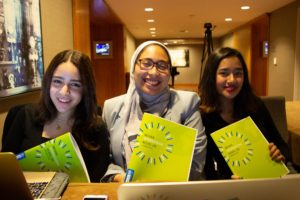The 5th WFUNA International Model UN (WIMUN) was held last week in New York City for its largest and most diverse year yet. Two Best Delegate staffers who were on-site reflect on their experience.
What is the ‘WIMUN Approach’? Understanding WIMUN by Madeleine Northfield
WIMUN operates like no other MUN conference I had ever been to before. The approach, dubbed the “WIMUN Approach” prides itself on using rules of procedure that follow as close to the actual United Nations as is possible in simulation form. What does this mean in committee? Well first of all, they don’t use the word committee, instead opting to use the word simulations. This is because committees are what is happening at the real UN and in MUN we are simply simulating them. Bill Yotive, the primary brains behind the WIMUN approach, helped train both staff and delegates in how to best participate in this approach. This year at WIMUN, a simulation was introduced to replicate the International Labour Organization, a UN committee which had never before been simulated at WIMUN. When talked about during the conference, the diversity in this academic experience is highly valued by the participants at WIMUN and hopefully in the years to come delegates can expect and even broader range of simulations.
Procedure at WIMUN is also very different ranging from the points one can raise to the organization of work throughout the weekend. At the very beginning of the simulation, delegates agree to the timeline of committee in a document called the “Organization of Work.” This outlines the agenda for the whole weekend and allows delegates to refer to it to better understand the timeline of the simulation. As well, there are no moderated or unmoderated caucus, only formal and informal debate which allow for speeches and writing of resolutions respectively. One of the last and most significant changes in procedure to North American MUN is that the chairs are students. Rather then have university students moderate debate, the simulation votes on students within it to moderate and assist in debate.
Overall, the differences in the WIMUN approach create an academic environment where learning and accurate simulation are the key objectives. It allows students to really get a feel for the way the UN operates. From the opening plenary to the closing of simulation being at the United Nations HQ, every aspect of the WIMUN approach feels true to the diplomatic process.
The Diversity of WIMUN 2019: A Quick Reflection by Curan VanDerWielen
WFUNA (World Federation of United Nations Associations), the organization responsible for the creation of WIMUN, ran its 5th iteration of its flagship New York City conference this past week, complete with 1,300 in attendance from 74 countries, and opening and closing ceremonies held at the actual United Nations Headquarters. This year’s conference was the largest WFUNA event on record, demonstrating how prevalent non-circuit styles of Model UN have become, despite how much attention the ‘competitive’ high school and collegiate circuits draw in North America. The diversity of participants attending the conference was perhaps its most unique attribute; conferences similar in size certainly garner international attendances, yet many participants come domestic. In the case of WIMUN, however, despite being held in the United States, the majority of participants were not American, but from a variety of locations, ranging across six continents.

WIMUN 2019 New York City was WFUNA’s largest conference to date
Considering the educational value of the ‘WIMUN Approach’ and the experience provided by WIMUN to actually hold parts of committees within the actual United Nations General Assembly Hall, I, as an American, found it strange that more American participants weren’t in attendance. Consider how much closer New York is for Americans, in comparison with the Chinese, Indian, South African, and Russian delegates who literally traveled across the globe just for the conference. And further consider how valuable genuine educational experiences regarding the United Nations can be for those in a country where international affairs, as a subject, is increasingly undervalued in most education systems, public or private. As a personal reflection, I found the phenomenon unusual. But perhaps this describes the prevalence of the ‘competitive circuit’ in North America, especially when compared to other regions where Model UN has found a strong foothold in extracurricular or educational programs. Or perhaps it demonstrates how rooted UNA-USA Model UN methodology has become in the region. Regardless, I’m extremely excited to see what WFUNA has in store for its upcoming conferences, which include WIMUN India on April 29th, and WIMUN Geneva on October 30th.

